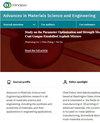使用可取性和 TOPSIS 方法对 OHNS 钢硬车削进行多目标优化
4区 材料科学
Q2 Engineering
引用次数: 0
摘要
在车削加工中,由于切削参数选择不当,很难加工硬度为 45-48 HRC 的硬质材料。OHNS(AISI/SAE-01-48HRC)钢主要用于生产轴、齿轮、凸轮和冲压工具。使用涂有 VP 涂层的硬质合金刀片在干燥状态下车削 OHNS 材料。采用中央复合设计(CCD)设计了十七个实验,并设置了不同的切削参数,如进给量、切削速度和切削深度。使用 Design Expert-11 软件的可取性方法和 TOPSIS(通过模拟理想解决方案进行排序优选的技术)对实验结果进行分析,以获得一个单一的最优解决方案,从而在金属去除率(MRR)和表面光洁度(Ra)方面获得更好的结果。RSM 方案的可取性为 81.3%,切削速度为 60 m/min,进给率为 0.08 mm/rev,切削深度为 1 mm,为最佳切削参数;同样,TOPSIS 算法计算确定了切削参数组合,如切削速度为 40 m/min,进给率为 0.09 mm/rev,切削深度为 1 mm,以提高加工钢材的质量;然而,可取性方法切削参数设置更有利于实现表面光洁度,而 TOPSIS 方案更有利于获得显著的 MRR。确认测试结果验证了两种方法的预测值;因此,实验结果比预测结果更方便。对于最佳切削参数组合,在切削速度为 60 m/min、进给速度为 0.08 mm/rev、切削深度为 1 mm 的条件下,获得了 22.032 gm/min 的 MRR 和 0.781 μm 的表面粗糙度。本文章由计算机程序翻译,如有差异,请以英文原文为准。
Multiobjective Optimization of Hard Turning on OHNS Steel Using Desirability and TOPSIS Approaches
Machining hard materials with 45–48 HRC is difficult in turning operation because of the improvident cutting parameter selections for the operation. The OHNS (AISI/SAE-01–48HRC) steel is mainly preferred for the production of shafts, gears, cams, and press tools. The OHNS material was turned at a dry state using VP-coated carbide inserts. The seventeen experimental trials were designed by central composite design (CCD) with different levels of cutting parameters, like feed rate, cutting speed, and depth of cut. Design Expert-11 software desirability approach and TOPSIS (Technique for Order Preference by Simulating the Ideal Solution) were used to analyse the experimental results to obtain a single optimal solution that defines better results on metal removal rate (MRR) and surface finish (Ra). RSM solution with 81.3% desirability, the cutting speed of 60 m/min, feed rate of 0.08 mm/rev, and depth of cut 1 mm as the optimal cutting parameters; similarly, TOPSIS algorithm calculation identifies the cutting parameter combinations, such as 40 m/min cutting speed, 0.09 mm/rev feed rate, and 1 mm depth cut to enrich the quality of the machined steel; however, the desirability approach cutting parameter setting is better for the surface finish achievement, while TOPSIS solution is better to obtain significant MRR. The confirmation test results validated for the predicted values of both approaches; as such, the experimental results were maintained better convenience than the predicted one. For the optimum cutting parameter combinations, an MRR of 22.032 gm/min and surface roughness of 0.781 μm were obtained at 60 m/min cutting speed, 0.08 mm/rev feed rate, and 1 mm depth of cut.
求助全文
通过发布文献求助,成功后即可免费获取论文全文。
去求助
来源期刊

Advances in Materials Science and Engineering
Materials Science-General Materials Science
CiteScore
3.30
自引率
0.00%
发文量
0
审稿时长
4-8 weeks
期刊介绍:
Advances in Materials Science and Engineering is a broad scope journal that publishes articles in all areas of materials science and engineering including, but not limited to:
-Chemistry and fundamental properties of matter
-Material synthesis, fabrication, manufacture, and processing
-Magnetic, electrical, thermal, and optical properties of materials
-Strength, durability, and mechanical behaviour of materials
-Consideration of materials in structural design, modelling, and engineering
-Green and renewable materials, and consideration of materials’ life cycles
-Materials in specialist applications (such as medicine, energy, aerospace, and nanotechnology)
 求助内容:
求助内容: 应助结果提醒方式:
应助结果提醒方式:


